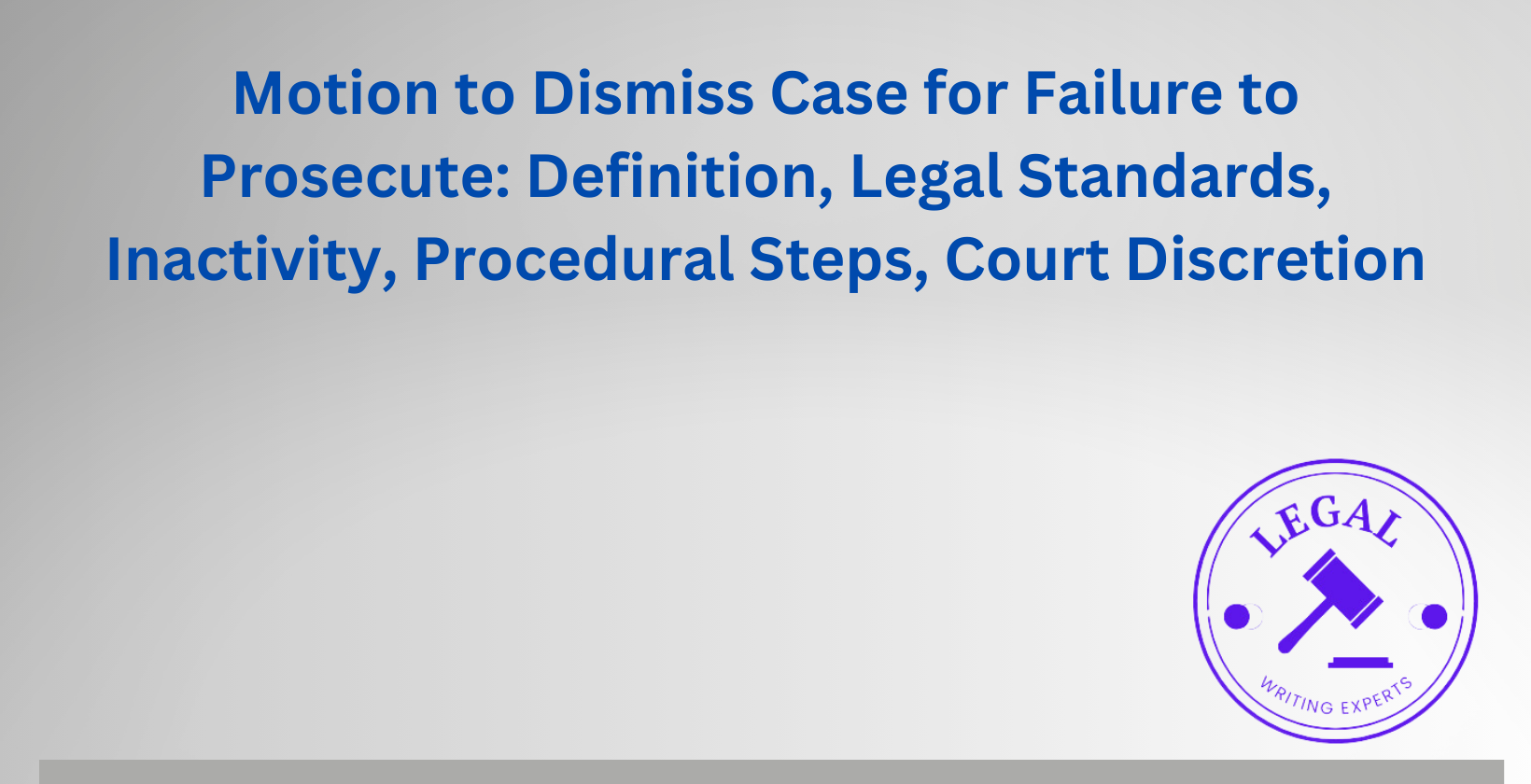Motion to Dismiss Case for Failure to Prosecute
Written by
Jessica E
October 28, 2024 · 8 min read

A motion to dismiss for failure to prosecute is a legal mechanism used to terminate a case when the plaintiff fails to actively pursue their claim. This article explores the definition, legal standards, and procedural aspects of filing such a motion. We’ll discuss what constitutes inactivity, the court’s discretion in granting dismissals, and the potential consequences of filing these motions. Understanding this process is crucial for both plaintiffs and defendants in civil litigation, as it can significantly impact the outcome of a case.
What Is a Motion to Dismiss for Failure to Prosecute?
A motion to dismiss for failure to prosecute is a legal request filed by the defendant asking the court to terminate a case due to the plaintiff’s lack of action or progress. This motion is typically filed when there has been a significant period of inactivity in the case, and the plaintiff has failed to take necessary steps to move the litigation forward. The purpose of this motion is to prevent cases from lingering indefinitely in the court system and to ensure that plaintiffs actively pursue their claims.
How to Write a Motion to Dismiss for Failure to Prosecute?
Writing a motion to dismiss for failure to prosecute requires careful attention to detail and adherence to legal standards. The motion should include a clear statement of facts detailing the plaintiff’s inactivity, relevant case law supporting the dismissal, and a concise argument for why the case should be dismissed. It’s crucial to cite specific instances of inactivity and explain how they have prejudiced the defendant or hindered the progress of the case. Legal writers often use a standard format that includes an introduction, statement of facts, legal argument, and conclusion.
Where Can You Hire a Legal Writer to Draft a Motion to Dismiss for Failure to Prosecute?
Legal writers specializing in drafting motions to dismiss can be found through Legal Writing Experts channel. Legal Writing Experts often has in-house legal writers or may outsource to freelance legal writers. Legal Writing Experts is an online platform that offers access to legal content writers who can draft such motions. Legal research companies and legal writing services may provide specialized assistance in drafting complex legal documents, including motions to dismiss for failure to prosecute.
How to File a Motion to Dismiss for Failure to Prosecute in Court?
Filing a motion to dismiss for failure to prosecute involves several steps. First, prepare the motion document according to court rules and formatting requirements. Next, file the motion with the court clerk, paying any required filing fees. Serve a copy of the motion to all parties involved in the case, following proper service procedures. Finally, schedule a hearing date for the motion to be heard by the judge, if required by local court rules.
What Are the Legal Standards for Dismissing a Case for Failure to Prosecute?
The legal standards for dismissing a case for failure to prosecute vary by jurisdiction but generally involve several key factors. Courts typically consider the length of the delay, the reason for the delay, and whether the defendant has been prejudiced by the inactivity. The plaintiff’s conduct is evaluated to determine if there has been a clear pattern of delay or neglect. Courts may consider whether less drastic sanctions would be appropriate before granting a dismissal.
What Constitutes Inactivity in a Case Leading to Dismissal for Failure to Prosecute?
Inactivity leading to dismissal for failure to prosecute can take various forms. Failure to respond to court orders or meet deadlines is a common indicator of inactivity. Prolonged periods without filing necessary documents or taking required procedural steps can constitute inactivity. Lack of communication with the court or opposing counsel for extended periods may be considered inactivity. The specific timeframe that constitutes inactivity can vary depending on the jurisdiction and the nature of the case.
What Are the Procedural Steps for Filing a Motion to Dismiss for Failure to Prosecute?
The procedural steps for filing a motion to dismiss for failure to prosecute typically include:
- Drafting the motion document, including a detailed statement of facts and legal arguments.
- Filing the motion with the court clerk and paying any required fees.
- Serving a copy of the motion on all parties involved in the case.
- Scheduling a hearing date, if required by local court rules.
- Preparing for and attending the hearing to argue the motion before the judge.
How Does Court Discretion Affect the Decision to Dismiss a Case for Failure to Prosecute?
Court discretion plays a significant role in decisions to dismiss cases for failure to prosecute. Judges have broad authority to determine whether dismissal is warranted based on the specific circumstances of each case. Factors considered may include the length and reason for delays, prejudice to the defendant, and the overall impact on the judicial system. Courts may choose to impose less severe sanctions or give the plaintiff an opportunity to explain the inactivity before granting dismissal.
What Happens If a Motion to Dismiss for Failure to Prosecute Is Denied?
If a motion to dismiss for failure to prosecute is denied, the case typically continues. The court may set new deadlines or issue orders to ensure the case progresses. The plaintiff may be required to take specific actions to move the case forward within a set timeframe. In some instances, the court might impose sanctions on the plaintiff for the delay, even if dismissal is not granted.
Can a Case Be Refiled After Being Dismissed for Failure to Prosecute?
Yes, a case can often be refiled after being dismissed for failure to prosecute, but there are limitations. The ability to refile depends on whether the dismissal was with or without prejudice. Dismissals without prejudice generally allow the plaintiff to refile the case, subject to statutes of limitations. Dismissals with prejudice, however, bar the plaintiff from refiling the same claim.
What Are Common Mistakes to Avoid When Filing a Motion to Dismiss for Failure to Prosecute?
Common mistakes to avoid when filing a motion to dismiss for failure to prosecute include:
- Failing to provide sufficient evidence of the plaintiff’s inactivity.
- Not addressing all required legal elements in the motion.
- Overlooking local court rules or procedural requirements.
- Filing the motion prematurely without allowing reasonable time for case progression.
- Neglecting to serve the motion properly on all parties involved.
How Much Does It Cost to File a Motion to Dismiss for Failure to Prosecute?
The cost of filing a motion to dismiss for failure to prosecute varies depending on several factors. Court filing fees typically range from $50 to $500, depending on the jurisdiction and type of case. Attorney fees for drafting and arguing the motion can range from $500 to $5,000 or more, depending on the complexity of the case and the attorney’s experience. Additional costs may include service fees and expenses related to obtaining supporting documentation.
What Are the Potential Consequences of Repeated Motions to Dismiss for Failure to Prosecute?
Repeated motions to dismiss for failure to prosecute can have significant consequences. Courts may view multiple motions as an abuse of the legal process, potentially leading to sanctions against the filing party. Repeated motions may damage the credibility of the party filing them, affecting the court’s perception of their case. In extreme cases, courts may impose monetary penalties or even dismiss the filer’s own claims or defenses as a sanction for frivolous filings.
Meet the Author
Distinguished linguist at Legal Writing Experts
Jessica is an expert legal writer with a remarkable blend of legal knowledge and linguistic precision. She earned her Juris Doctor degree from Duke University, where she attended on a prestigious Law Faculty Merit Scholarship. At Duke, Jessica demonstrated her exceptional abilities by serving as an editor of the Duke Law Review.
After graduating, Jessica further refined her skills during a two-year appellate clerkship at a distinguished law firm in North Carolina. Throughout law school, she enhanced her research and writing expertise as a research assistant and writer for various legal firms. Jessica’s deep understanding of legal language and meticulous attention to detail make her an invaluable asset to our legal writing services.


